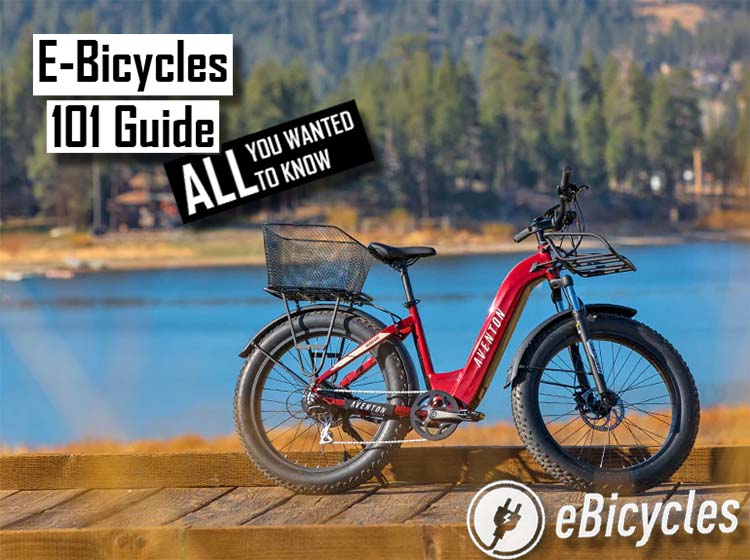
Image source: Aventon.com
Electric bicycles (also known as e-bicycles, pedelecs, pedal-assist bikes, and electric-assist bikes, are becoming an increasingly common sight on the streets around the world.
Though many are still confused about their traits and benefits, e-bikes have had an undeniable role in putting more and more people on two wheels, enabling them to spend more time outdoors.
E-bikes combine an electric motor and battery with the traditional bicycle frame to provide a boost in power that makes pedaling uphill and accelerating from a dead stop much easier.
If you’re in two minds about whether or not an e-bike is the right choice for you, or you have trouble choosing the right one, this comprehensive guide will tell you ALL there is to know to make the right decision.
All you need is around 15 minutes to read through the information below and order your next e-bike.
What you will learn today:
- What Is an E-Bike?
- Who Are Electric Bikes For?
- Why Should You Get an E-Bike?
- Why Are Electric Bikes Trending?
- Electric Bicycle Parts that Make an E-Bike
- The Three Classes of Electric Bicycles
- Assist Levels and the Range
- How To Choose the Right Electric Bike?
- How Much Should You Spend on an Electric Bicycle?
- Electric Bike Brands
- DIY E-bikes
- Common Myths About E-Bikes
- Frequently Asked Questions
What Is an Electric Bike?
Put simply, an electric bike is a bicycle with an integrated electric motor and battery that assists the rider while pedaling. However, an electric-assist bike is not a scooter, though some types come with a throttle.
To classify as an electric bicycle, it needs to have pedals and the motor should only assist the rider when pedaling, instead of propelling them at all times like a scooter.
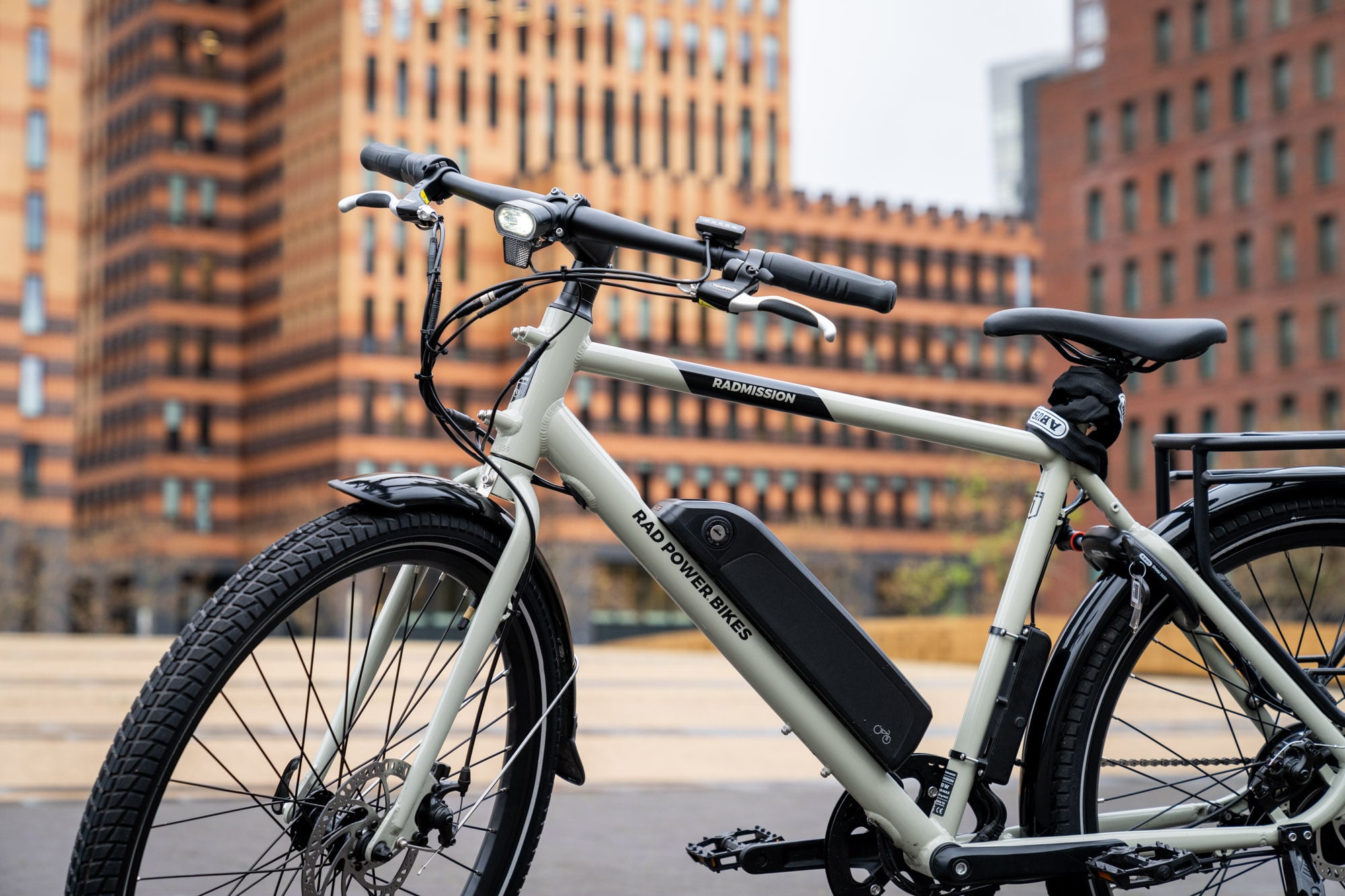
E-bicycles typically have a rear hub or a mid-drive motor, paired with a frame-mounted battery pack, along with a traditional drivetrain. (Image source: Radpowerbikes.com)
If you wish, you can pedal on your own, without any assistance, and then ramp up the assistance level when you come across a steep hill or become tired.
Depending on the country and the local laws, electrically-powered bicycles usually have a maximum assisted speed between 15 mph and 28 mph.
Electric-assist bicycles usually have power or cadence sensors which allows them to gauge how much power to supplement the rider with, depending on how FAST or how HARD they’re pedaling at a given time.
- Read more: What Is an Ebike? Full Guide
Who Are Electric Bikes For?
Electric bicycles are a good choice for anyone who likes cycling but does not like becoming too tired by pedaling very hard.
They’re excellent for:
- Commuting
- Rehabilitation
- Fitness
- Elderly
If you commute on a daily basis (in or out of the city), an e-bike is a great way to get to your destination quickly, without breaking a sweat. If you struggle with an acute or a chronic injury, an e-bike can allow you to pedal without straining your muscles and joints too hard. Electric bicycles are also a phenomenal choice for the elderly, who are not as fit as they used to be, as well as for those who are trying to get more fit and lose weight.
But they’re not limited to these four groups. If you’re simply a regular Joe who wants to have fun and zoom around town on an electric pedelec, there shouldn’t be anyone stopping you.
Why Should You Get an E-Bike?
There are many right reasons to get an e-bike and no wrong reasons. There are as many ways of using an electric bike as there are traditional bikes, if not more. You can commute, run errands, haul cargo, get fit, or ride leisurely.
One of the main reasons why people get an electric bicycle is because they want to ride farther or go faster than their bodies allow them to on a traditional bike. On an electrified bicycle, you can cover significantly greater distances in the same amount of time while getting much less tired. Who wouldn’t like that?
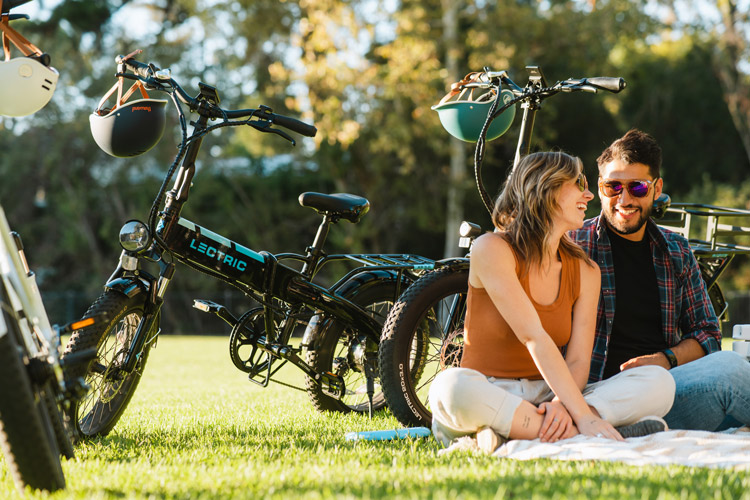
Electric bikes let you ride further and enjoy the ride more. (Image source: Lectricebikes.com)
Some hardcore cyclists might consider e-bikes to be a way of cheating (which is far from the truth), but they’re not primarily intended for performance cyclists anyway. Instead of cheating, we call it “playing smart”.
Electric bikes can also help you save a lot of money in the long run if you replace your car with one. You’ll not only save money on gas but also on car maintenance fees, as well as on medical costs by improving your health and lowering your risks of chronic diseases.
Last but not any less important, electric bikes are a blast to ride! Once you feel the push they provide and feel the ease with which you can accelerate and maintain speed, it’s hard to go back!
Why Are Electric Bicycles Trending?
If you pay some attention to your surroundings on your morning commute, you’re likely to see more electric bicycles on the road than ever before. Why is that?
There are two main reasons:
- Electric bicycles are becoming cheaper.
- People are realizing the benefits of e-bikes and overcoming stereotypes.
Namely, electric bicycles are a lot cheaper now than they ever were. Budget-oriented people can get a basic model for less than $1,000 that will get the job done. The reason is that battery production costs are dropping and the other electric components are becoming cheaper and more accessible as well.
Servicing an electric-assist bicycle is a lot easier nowadays as well, as there are more mechanics who understand how these electric machines work and know how to repair them.
Electric bicycles are also a lot “greener” and better for the environment than cars with internal combustion motors. That’s becoming an increasingly important factor for a lot of people when choosing their preferred mode of transportation in the face of global warming and climate change.
Electric Parts that Make an E-Bike
At first glance, electric bikes are not much different than traditional bikes. They have a similar frame, two wheels, pedals, handlebars, and a traditional drivetrain. However, they also have a few components that you’re not likely to find on an ordinary bicycle.
The components in question are the electric parts such as the motor, battery, controller, throttle, pedal-assist sensors, and display. The motor is the heart of the electric system, whereas the other components center around it, allowing it to power the bike and assist the rider.
Let’s learn more about how these components work and what their roles are.
- Related guide: How Do Electric Bikes Work?
The Motor Explained
The motor is the most important electric component of any electric bicycle. It’s what gives you the power to overcome a steep hill, fight headwinds, or keep pedaling when you feel all your energy is drained.
Depending on how much money you want to spend and how you plan to use your electrically-powered bicycle, motors differ in terms of type and placement.
The three main types of motors commonly found on modern electric bicycles are direct-drive, geared hub, and mid-drive motors.
-
Direct Drive

Direct-drive hub motors are cheaper than geared hub motors but are not as popular anymore. (Image source: Radpowerbikes.com)
Direct drive motors are the cheapest type you can get, but they come with some advantages and disadvantages. They’re usually placed either on the front or on the rear wheel, depending on the price of the bicycle. The cheapest e-bikes come with front-hub direct drive motors.
DD motors have no gears. This means that the motor makes one rotation every time the wheel makes one rotation. That’s a great solution on flat terrain while the wheel is spinning quickly because the motor can provide a lot of power. However, it’s a poor setup on steep hills when the wheel is spinning more slowly so the motor makes fewer rotations as well.
One of the benefits of DD motors is that they cool more efficiently, so they are often more durable than geared hub motors, even though they’re not as practical.
-
Geared Hub Motor

Geared hub motors are quieter and better for climbing hills than direct-drive hub motors. (Image source: Aventon.com)
As you may guess, geared hub motors are placed inside the wheel hub and they have gearings. They’re commonly placed inside the rear wheel hub and are seen on mid-range electric bicycles.
The benefit of geared hub motors is that the motor can turn several times (typically around 5) for each rotation of the wheel, thanks to its geared nature. This is good for steep uphill rides because the motor can still deliver sufficient power, even though the wheel is turning slowly.
The disadvantage of this motor is that it does not dissipate heat as well as DD motors. The entire motor and gearing is placed inside a compact casing, which looks good, but traps heat even better.
-
Mid-Drive
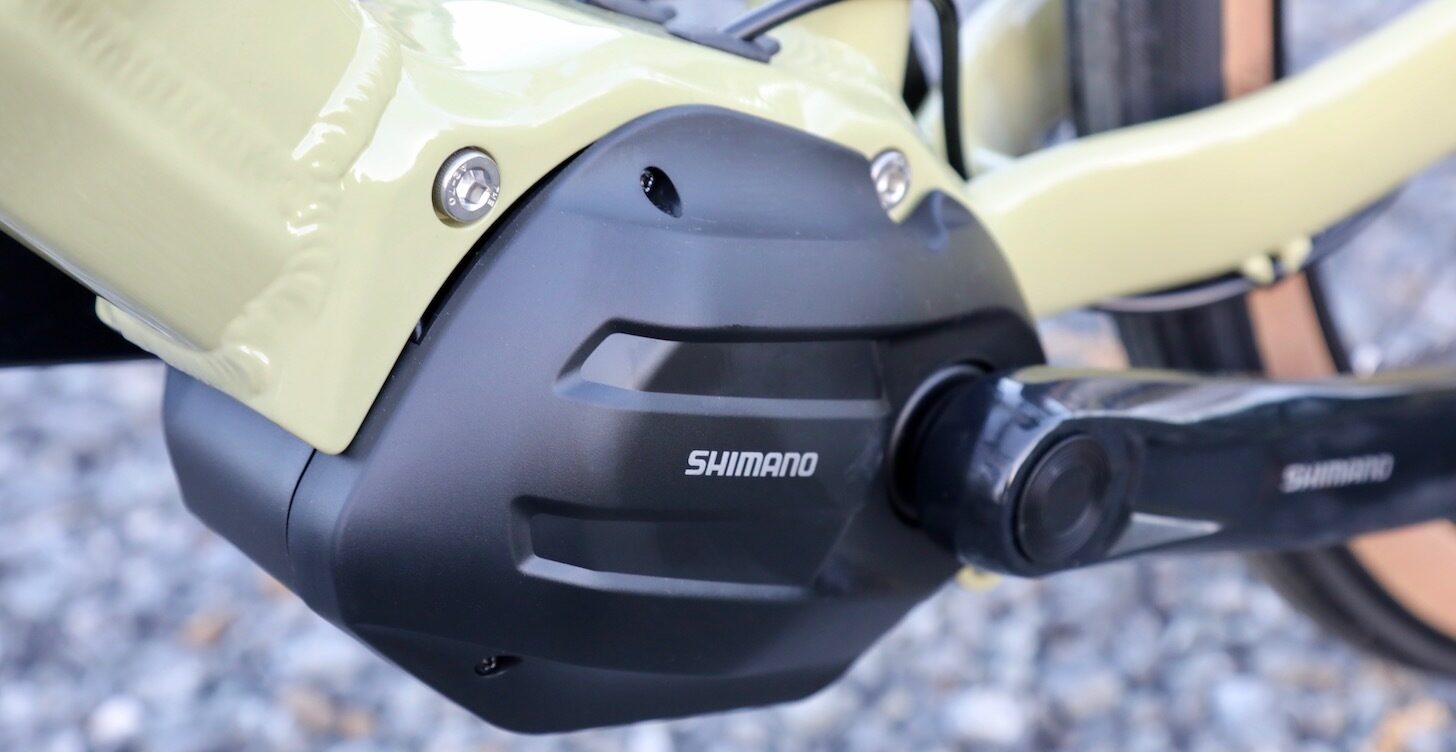
Mid-drive motors are most common on more expensive bikes, offering the best riding experience and the most hill-climbing power. (Image source: Marinbikes.com)
Mid-drive motors are the best type you can get. As such, they’re often found on more expensive mid-range e-bikes and on high-end models.
Because mid-drive motors usually have torque sensors and supplement power directly to the pedals, they often feel more natural than hub motors. Torque sensors analyze how HARD you’re pedaling instead of how fast your wheels or pedals are turning, which means you’ll get assistance when you need it the most.
Mid-drive motors are also geared, though they have a separate gears housing, so they can be geared a lot lower than geared hub motors. That makes them the best choice for e-MTB and e-Road bikes.
These motors also have the ability to change the gearing ratio for optimal power output, which is what makes them the superior choice.
Motor Placement Effect on Ride Feel
Another factor you need to consider when choosing which e-bike to get is the effect of the motor’s position on ride feel.
Namely, front-hub motors act similarly to front-wheel-drive cars. They’re nippy and responsive in the corners, but they don’t have as much traction as rear-wheel types.
Consequently, rear-hub motors improve traction because there is more weight on the rear wheel due to rider placement. They also provide more stable handling and need to be more sophisticated because they interact with the gears and other parts at the rear of the bike.
Finally, mid-drive motors are the best choice because they are located low, right under your center of balance. They make the bike more stable and make for a more natural riding feel.
The Battery Pack Explained
The battery pack provides the motor with energy and determines the range. Batteries used to be big, expensive, and heavy, but they are usually none of those things today.

The battery pack is typically placed on top or inside the downtube, depending on the manufacturer and the price range of the e-bike. (Image source: Marinbikes.com)
Modern batteries on expensive e-bikes usually fit inside the downtube, so they are placed completely out of sight. Cheaper models usually have batteries placed on the downtube or on the rear rack, plus they are heavier and don’t look as good.
-
Types
Almost all modern electric bicycles come with lithium-ion batteries. However, in the past, e-bikes used to be powered by lead-acid, nickel-cadmium, or nickel metal hydride batteries. These are now considered to be outdated because they are heavier, less durable, and less eco-friendly.
Lithium-ion batteries are the same type that’s found in electric cars and most other electronic devices we use every day, including smartphones and laptop computers.
-
Capacity
Battery capacity is usually measured in Amp-hours (Ah) or Watt-hours (Wh). The two basically measure the same thing, but Watt-hours is becoming the standard measurement because it is more consumer-friendly.
Since most e-bikes nowadays have 36V motors, you can easily convert Ah to Wh by multiplying the battery capacity in Amp-hours by the voltage of the motor. Thus, a 10 Ah battery usually equals a 360 Wh battery (10Ah x 36V = 360Wh).
Cheap electric bicycles can have a battery capacity in the range of 150–200Wh, whereas the most common range is 300–500Wh. More expensive models can have bigger batteries with capacities of over 600Wh, up to even 1,000Wh.
An exception to this rule is Rad Power bikes which are considered to be entry-level but have 672 Wh batteries, which is deemed quite high.
-
Charging & Durability
Depending on the manufacturer, battery capacity, and build quality, a full charge typically takes between two and a half and six hours. If your battery is at the higher end of this range, you can simply charge it overnight.
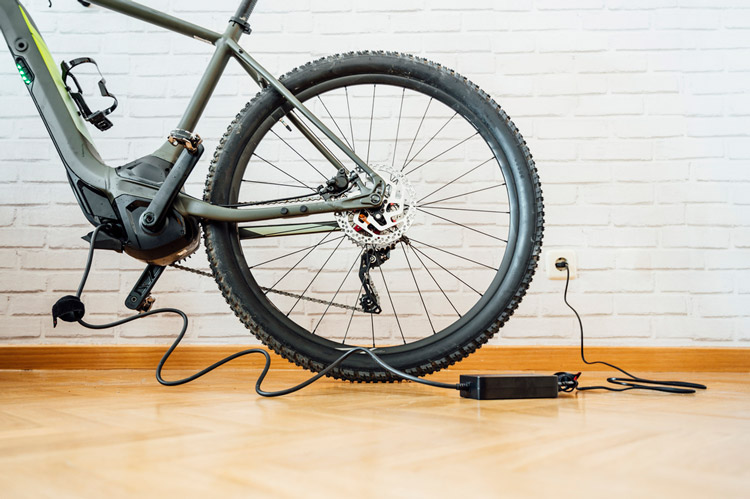
Depending on the baterry size and make, you should be able to get a full charge within 4-6 hours
Lithium-ion batteries are usually rated for around 800 full charge cycles. That equals around three years of weekday commuting. However, most manufacturers claim that you can get around 2,000 half-charge cycles, which means that it is advisable to charge your battery whenever you get a chance.
With proper care, which means storing the battery away from extreme heat and cold, you can usually get even more life out of your pack.
Once the battery dies or its durability significantly decreases, you can simply replace it with a new one.
Controller
We won’t go into too much detail about controllers here. The reason is that they are a bit more complex than other components and not as important for beginners to understand.
A controller basically serves as a “bridge” between the battery and the motor, controlling the speed of the motor and the amount of power it drains from the battery.
Therefore, controllers are very important when it comes to the range of the bike, the amount of assistance a motor can provide, and the ride feel.
Pedal-Assist Sensors
Pedal-assist sensors are another important part of electric bicycles that you should understand. Namely, there are two types of these sensors:
- Cadence
- Torque
A cadence sensor is basically a magnetic ring that attaches to the cranks and tells the motor how fast you’re turning the pedals. This way, the motor determines how much power to send your way. Cadence sensors are found on cheaper electric bikes because of their apparent downsides compared to torque sensors.
Torque sensors, on the other hand, tell the motor how hard you’re pedaling, which is why they are the superior choice. When the sensor detects you’re exerting more power on the pedals, it will instruct the motor to provide you with more assistance.
Display
The last piece of the electric bicycle puzzle is the display. Most e-bikes use either simple LED displays or more complex LCD displays.
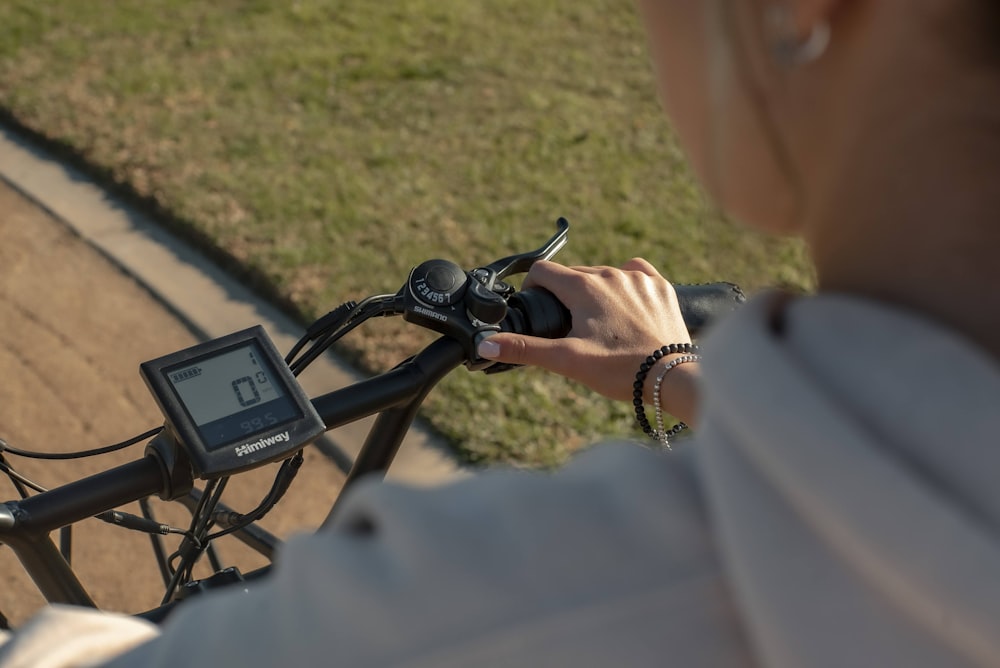
An e-bike display will usually show your current speed, pedal assist level, remaining battery, and allow you to change the battery’s settings.
LED displays simply have a series of LED lights that show the remaining battery charge and the pedal-assist level, along with a few buttons to control the bike.
On the other hand, LCD displays are found on more expensive models and provide the rider with more options and more information. In addition to showing the pedal-assist level and battery charge, they can also track rides, showing distance, speed, time, odometer, and a few other functions.
The Three Classes of Electric Bicycles
The e-bike industry and the legislators in the US recognize three distinct categories of e-bikes. These differ in terms of having or not having a throttle, as well as in terms of the maximum assisted speed.
These three categories are called classes. However, it’s important to note that these “classes” have nothing to do with the product quality. Therefore, a Class 1 e-bike is in no way inherently better than a Class 2 or a Class 3 e-bike. They just have different characteristics and components.
Class 1
Class 1 e-bikes are electric bicycles that are only pedal-assist and don’t have a throttle. These bikes have a maximum assisted speed of 20 mph. To go faster than that, the rider needs to turn the pedals and propel the bike solely with the power of their legs.

Co-op Cycles CTY e2.1 is a class 1 e-bike with a 20 mph top assisted speed and no throttle. (Image source: REI.com)
In parts of Europe, this Class is, in fact, limited to 15 mph with motor wattage up to 250W. In the USA, motor wattage is limited to 750W.
Class 1 e-bikes are usually city bikes that are meant for urban commutes and recreational riding. This is also the most common and the most affordable class of e-bikes. These bikes can generally be ridden everywhere a traditional bike is allowed, without any need for additional licensing.
Class 2
Class 2 e-bikes have the same maximum allowed speed as Class 1 models, which is 20 mph. However, in addition to the pedal-assist function, they also have a throttle. Therefore, they can be ridden both as a pedelec and as an electric scooter.

Charge City is a popular class 2 e-bike with a 20 mph top assisted speed, as well as a thumb throttle. (Image source: Chargebikes.com)
Class 2 electric bicycles are less common than Class 1 models because they are usually more heavily regulated in many countries around the world. The throttle is usually added to cargo bikes and heavier city and mountain bikes to help riders pick up speed more easily when starting from a dead stop.
In parts of Europe, Class 2 e-bikes are considered to be motor vehicles, so they are banned from trails and other bicycle infrastructure. Their top speed is also limited to 15 mph, with motor wattage of up to 250W.
Class 3
Class 3 e-bikes are pedal-assist only, but their maximum assisted speed is limited to 28 mph. They have no throttle, so the motor assists the rider only when the pedals are turning. This type is also called “Speed Pedelec”.

Class 3 e-bikes have no throttle and assist the rider up to 28 mph. (Image source: REI.com)
E-Road and E-MTB bikes are commonly built as Class 3 bikes because their riders are more performance-oriented and require higher maximum and average speeds. However, in some places in the US and around the world, Class 3 e-bikes are considered motor vehicles and require a license to ride.
Assist Levels and the Range—How Far Can an E-Bike Really Go?
One of the most important factors most future e-bike owners consider is the range. How far your electrically powered bicycle can go on one charge makes all the difference. The last thing you want to do is run out of battery mid-ride, having to pedal the bike over a steep hill. An e-bike with an empty battery is just a heavy bike.
The range of your e-bike is determined by two main factors:
- Battery capacity
- Assist level you use
However, other variable factors include your weight, your position on the bike, tire pressure, the terrain, riding style, etc.
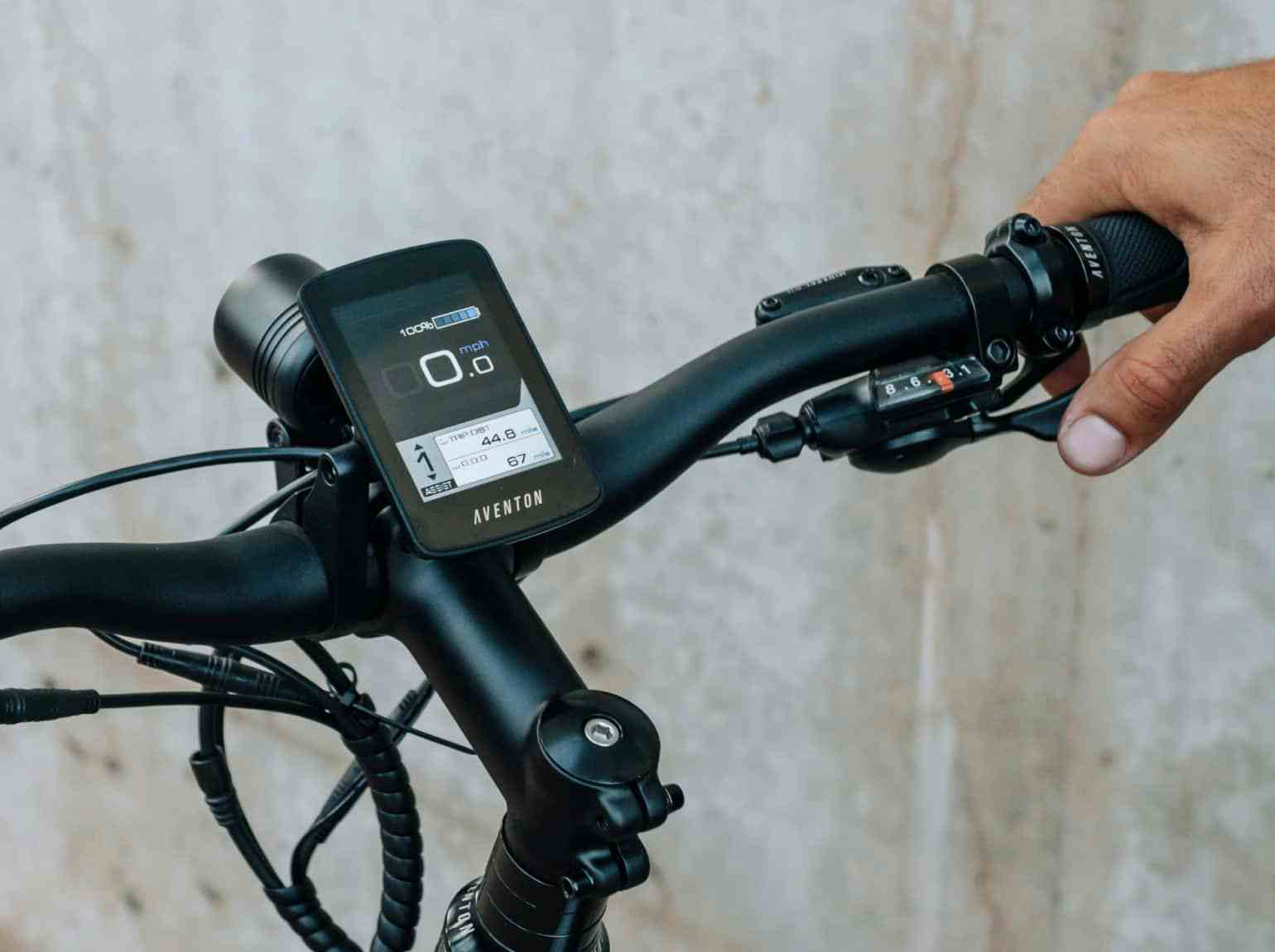
An e-bike display will show you the current assist level you’re in, as well as the remaining battery capacity or estimated remaining range. (Image source: Aventon.com)
A battery with a higher capacity will give you more range, but it will also weigh more and increase the cost of the bike. Therefore, you should try to determine how much range you really need. Still, you should buy an electric bike with more range than you think you need, as that way you don’t need to charge the battery as often. Also, the range will drop as the battery ages, which is why it is advisable to have a higher capacity to start off.
To estimate the minimum range you can get from your e-bike, you can divide your battery’s capacity in Watt-hours by 20. Therefore, a 350Wh battery should give you at least 17.5 miles of range. But, if you’re prudent and you use low assist levels, you can get as much as 40-50 miles out of the same battery.
Assist Levels Explained
All e-bikes allow you to choose the amount of assistance you need from the motor by selecting the appropriate assistance level. Most bikes have between 3 and 5 assist levels, while some also have a “walk mode” that assists you while pushing the bike.
Naturally, the higher the assist level you choose, the more power the motor will send your way, the easier you will have to pedal, and the faster you will go. At the same time, as the assist level increases, the range of your e-bike decreases. So it’s important to find some golden middle.
- Read more: Throttle vs. Pedal-Assist Explained
When it comes to the throttle, most models allow you to fine-tune the amount of power you get by twisting the throttle to a certain degree. Therefore, using a throttle does not automatically mean that you will be draining your battery faster.
How To Choose An Electric Bike?
It’s quite easy to become overwhelmed and confused when you first come across the huge number and variety of electric bicycles on the market.
But choosing the right type of e-bike and staying happy and content with it is easier than you think. You should consider the type of bike you need, the style, the cost, and a few other factors.
To simplify things, all you need to do is follow the steps we’ve listed below until you end up with the best e-bike for your needs.
So, the first step is:
#1: Choosing the Right Type
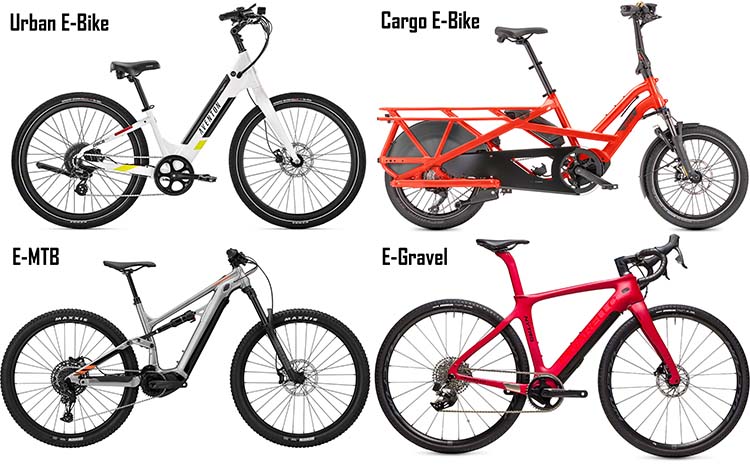
E-Bikes come in all different shapes and sizes, suitable for different types of riders and uses.
Just like regular bikes, e-bikes can be split into several categories based on their intended use. It’s important to think hard about what type of riding you plan to do the most in order to get the electric bike that meets most of your requirements.
-
Mountain E-Bikes
The electric mountain bike market is one of the fastest-growing sectors in the industry. Mountain bikes are generally considered to be heavier and more robust than other types, so many riders don’t mind the added weight of the motor and battery.
Most e-MTBs are Class 1 or Class 3 bikes, but there are Class 2 models as well. Mid-drive motors are considered a standard in this category because of the smoothness of power they deliver.
The batteries are usually located on the downtube or are integrated inside the downtube and vary in capacity, with 400-500Wh being the average.
There are different types of e-MTBs you can get, such as hardtail and full-suspension, enduro, trail, XC, and so on.
-
Road E-Bikes
Electric road bikes are not as popular as other types because they are generally more expensive. Weight is very important for road cyclists, which is why e-road bikes usually have sophisticated lightweight batteries integrated into the downtube, as well as expensive lightweight motors.
Most e-road bikes are Class 3 models, with a 28 mph maximum assisted speed. Their battery capacity and range differ from one model to another but are generally higher than on other types. For example, the Specialized Turbo Vado promises a range of 80–100 miles with a 320–480Wh battery.
-
Folding E-Bikes
Folding electric bikes are becoming increasingly popular in urban areas. They are usually used by commuters in the city because they are easy to store and transport.
Folding e-bikes typically have 20″ wheels and rear wheel hub motors. They are often Class 1 or Class 2 models, so they come with or without the throttle function.
Most budget models have 250W motors, but there are more powerful models with 500W or even 750W motors, with higher capacity batteries as well.
-
Hybrid E-Bikes
Hybrid electric bicycles are available with different setups and in different price categories. They can either be cheap and intended for recreational riders or expensive and intended for fitness riders.
This type is quite popular because of the practicality it offers. Step-through electric bikes, in particular, provide easy mounting and dismounting. It typically has wider tires, so it can be ridden on paved and unpaved roads. Depending on the price tag, your e-hybrid bike can have a 250W, 500W, or 750W motor, with or without the throttle.
-
Cruiser and City E-Bikes
Cruiser and city e-bikes are usually the cheapest options on the market. They are often built around frames made from steel or aluminum. Many cruiser and city electric bicycles have medium-capacity batteries mounted on the rear rack or on the seat tube.
E-cruiser and e-city bikes are usually Class 1 or Class 2 bicycles with a 20 mph maximum assisted speed. They are also often quite heavy and powered by geared or direct-drive hub motors.
Best Cruiser Electric Bikes Best City Electric Bikes
-
Cargo E-Bikes
Electric cargo bikes are becoming more and more popular, especially in big cities. Families are using them as a replacement for their car, to save money on gas and maintenance costs. An electric cargo bike can typically carry two kids or up to 120 lbs of cargo on its integrated rear rack, which is more than enough for most ordinary people.
E-cargo bikes often have more powerful mid-drive or geared rear hub motors and many come with a throttle. This allows the rider to have more control over the pedal-assisted power, which is especially important when starting to pedal fully loaded.
#2: How Often and How Far Do You Ride?
Now that you’ve determined what type of e-bike would suit your needs the best, you need to think about how often and how far you plan to ride.
If you plan to ride frequently and do longer commutes, you should invest more in your electric bicycle in order to get better and more durable components.
More money will also get you a better battery and more range. If you ride every day or do long miles, you’ll be annoyed if you have to charge your bike every day or even carry a spare battery, just in case.
#3: Where Do You Ride?
Consider where you plan to ride. Are you going to be riding mostly in the city on smooth pavement or in the country on dirt roads? Also, do you plan to ride on flat or hilly terrain?

Electric mountain bikes are ideal for rides on extreme off-road terrain. (Image source: Marinbikes.com)
If you plan to ride in urban conditions, you should get a city, cruiser, or a folding bike. These will prove to be the most comfortable and the most practical choice. If you ride off-road, get an e-MTB bike, or go with an e-hybrid model if you plan to do a little bit of both.
Depending on what kind of terrain you plan to tackle, you can choose between direct drive motors on the one hand and geared hub or mid-drive motors on the other. Direct drive motors are a good budget option for flat terrain. However, if there are many steep hills in your area, it is advisable to go with a geared hub or mid-drive setup.
#4: Getting the Right Size
Once you’re certain about the type and model of e-bike you want to get, make sure to get the right size. Many cruiser, city, folding, and cargo electric bicycles are built around one-size-fits-all frames. In reality, these frames don’t fit EVERYONE. They are often too big for very short riders or too small for very tall riders.
To get the right frame size based on your height and inseam length, consider a good bike size chart or our bicycle size calculator. If you get the wrong frame size, you’ll feel uncomfortable when riding, and you might even end up with pain or serious injury.
#5: E-Bike Features and Accessories to Consider
For some riders, certain features and accessories can be absolutely essential. For other riders, these can be redundant and just increase the price of the bike unnecessarily.
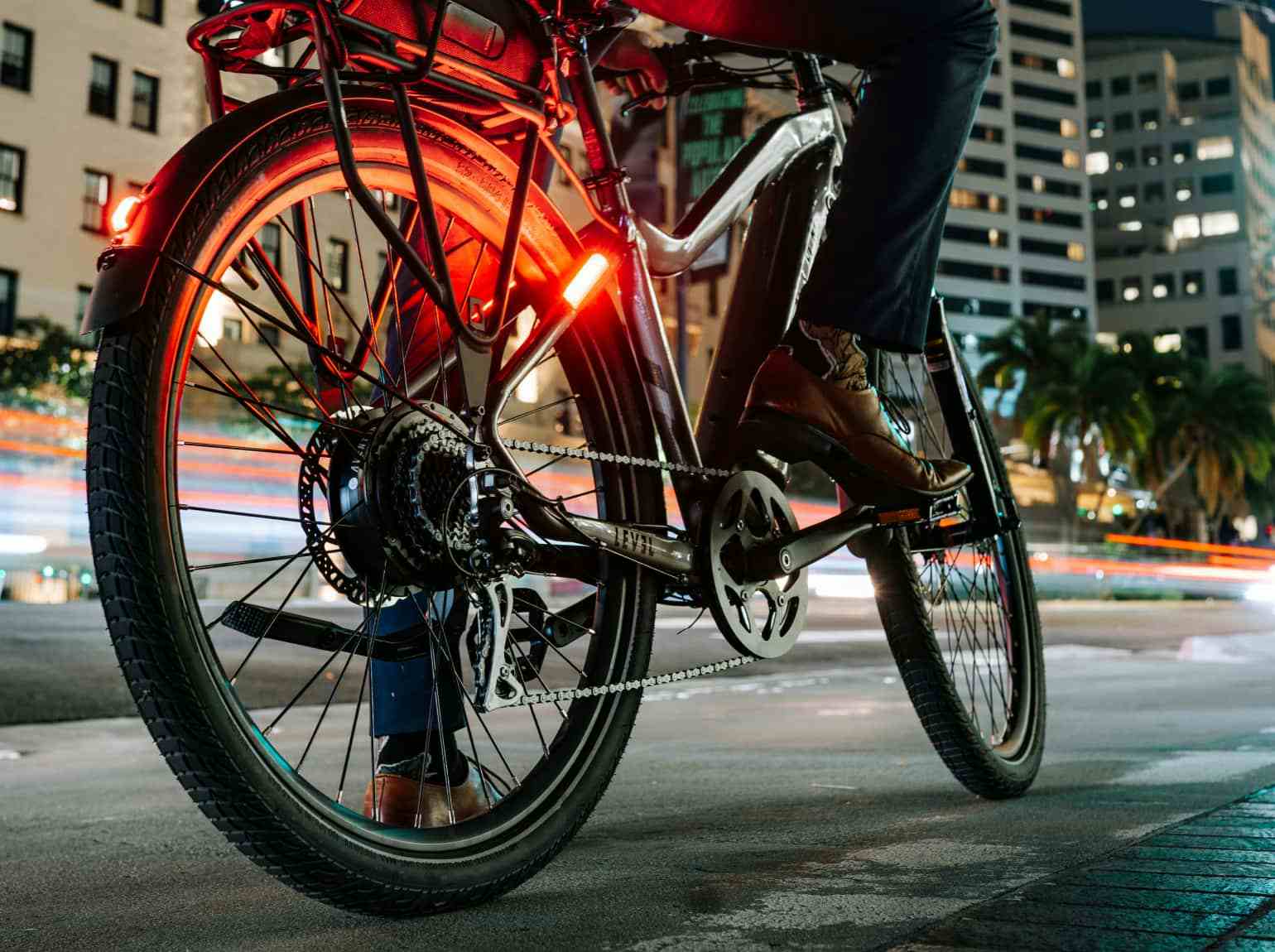
If you ride in urban conditions, look for an e-bike with front and rear lights, fenders, a rear rack, and a kickstand. (Image source: Aventon.com)
Here are a few popular features and accessories you should consider when buying an e-bike.
- Throttle: A throttle is a great feature if you need help starting the bike. It’s a great addition to cargo bikes or city bikes that you plan to use for hauling additional weight or taking your kids to school. However, the throttle will turn your e-bike into a Class 2 bike that might be subject to additional regulations.
- Lights: Most e-bikes have integrated front and rear lights powered by the battery. We believe this is a must. On some bikes, the taillight also functions as a brake light, improving the visibility and safety of the rider.
- Racks: Many electric-assisted bicycles have an integrated rear rack. This is a good thing if you plan to carry cargo or take your kids for a spin. Otherwise, an integrated rear rack will just add unnecessary weight.
- Display: Consider what kind of display you’d like your e-bike to come with. Cheaper models have simple displays with LED indicators for battery charge and pedal-assist level. They don’t track your rides or show ride metrics such as speed, time, distance, odometer, etc. If you want these functions, get an e-bike with a more expensive LCD screen.
- Smartphone Integration: Some modern high-end e-bikes will connect to your smartphone via Bluetooth and a dedicated app. This way, you can track your rides, track your bike with GPS, gain access to service records, and so on. This is a fun feature to have if you have a higher budget.
How Much Should You Spend on an Electric Bicycle?
Now that you know what kind of e-bike is right for you, you should also consider how much money you’d like to spend. Just like traditional bicycles, electric bikes come at different price points, from ultra-cheap to ultra high-end. Therefore, you get what you pay for.
Let’s take a closer look at some examples of price points, so you can determine which range would cover most of your needs.
- Read more: How Much Does an Electric Bike Cost?
Ultra-Cheap: Under $500
Ultra-cheap electric bikes that cost less than $500 are not an option we recommend, but they’re still available on the market. In the majority of cases, these are imported Chinese brands with very basic and unreliable components.

Amazon sells a large number of e-bikes under $500, but you typically get what you pay for.
They’re usually built around compact frames with small wheels, no-name bike parts, weak motors, and small capacity batteries. You really get what you pay for.
If you plan to use your e-bike for serious, regular commutes and ride it more than once in a blue moon, we recommend moving on to the next category.
Best Electric Bikes Under $500
Entry Level: $500 to $1,000
The price range up to $1,000 consists of significantly more reliable models. These are still basic, budget e-bikes, but they’re equipped with noticeably better components. There are plenty of compact e-bikes, cruisers, and city bikes, in this price category.
The majority of these bicycles have unimpressive 250W motors, slightly better batteries than the previous category, and entry-level Shimano components, such as Tourney. You can get a bike from this price range for regular use, but don’t expect too much in terms of power and range.
Best Electric Bikes Under $1,000
Mid-Range: $1,000 to $3,000
This is the right category for real e-bike enthusiasts who don’t want to break the bank but want to get good value for their money. By spending more than $1,000 on your e-bike, you’ll get significantly better electrical and mechanical components.
These electric-assist bicycles use better aluminum frames, better wheels and tires, and higher-quality components and brakes from Shimano, SRAM, and Tektro.
The motors offer more power (500W or more) and batteries usually have upwards of 400 Wh capacity. If you want an e-bike that you can use and abuse every day to commute, transport kids, or haul cargo for years, this is how much money you should be looking to spend.
Best Electric Bikes Under $2,000
Premium: $3,000 to $5,000
Electric bicycles that cost upwards of $3,000 come with high-quality components. You won’t find any cheap brands or crappy parts. This goes for the motor and battery, as well as for the frame, wheels, drivetrain, brakes, and so on.

Tern’s folding electric bikes come at a premium but offer a large number of high-end features and rider-friendly solutions. (Image source: REI.com)
In fact, this is the price range where you stop seeing hub motors. These are replaced by mid-drive motors from renowned companies such as Bosch, Yamaha, Brose, Shimano, and others. They offer much better performance and more natural assistance than hub motors.
If you’re buying an electric mountain bike, this price range will get you better suspension (hardtail or full-suspension) and even a full-carbon frame as you approach the $5,000 price tag.
High-End: $5,000 to $10,000
Finally, if you have money to spare and you want the best of the best in terms of performance, motor power, battery capacity, and bicycle components, you should be spending between $5,000 and $10,000.
This is where all the superbikes are, usually intended for mountain bikers and road cyclists who need an additional push when out and about.
Interestingly, though, the electrical components here are not much better compared to the price range just below. However, all other components are. You get a premium suspension, high-grade carbon frames, electric shifting, and other mouth-watering stuff.
Electric Bike Brands
As e-bikes have exploded in popularity in recent years, in the USA and worldwide, we’ve been seeing more and more quality brands popping up.
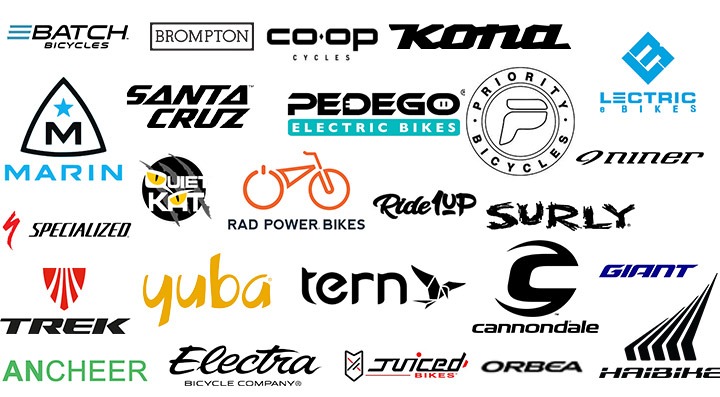
There are dozens of brands on the market that specialize in manufacturing e-bikes, with new ones popping up on a regular basis.
If you’re new to the e-bike world, you might not know which brands to trust and which to stay away from. For that reason, we’ve created this list of the most reliable and renowned electric bike brands whose bikes are commonly found on the market.
They’re not mentioned in any particular order, so you can expect decent quality bicycles in different price ranges from all of them.
-
Trek
Trek is one of the biggest bicycle manufacturers in the world, with one of the biggest selections of e-bikes as well. They offer recreational electric models, but also high-end e-MTB and e-road performance bikes. Trek also owns Electra, another popular e-bike brand that specializes in city and cruiser e-bikes. Both Trek and Electra models are equipped with Bosch electronic parts, which guarantees quality and durability.
-
Ancheer
Ancheer specializes in budget electric bikes that cost under $1,000. They make folding, MTB, hybrid, and city electric bikes. This brand is recommended for e-bike beginners with a limited budget, who don’t intend to ride too seriously. The motors are typically 250W to 500W with up to 12Ah batteries.
-
Sondors
Sondors is a USA-based company that makes quality mid-range e-bikes in different categories, many of which are pretty unique. It produces fat bikes, city bikes, folding bikes, MTBs, and retro moto-like e-bikes. Sondors electric bicycles are popular for their authentic design, powerful 500W or 750W motors, and massive batteries with up to 1,000 Wh capacity.
-
Jetson
Jetson makes ultra-budget scooters and e-bikes that typically cost under $500. This is a Chinese-based company whose products are quite popular on Amazon. They mostly make compact e-bikes with or without pedals, but they have some more expensive hybrid and MTB models as well.
-
Schwinn
Schwinn is one of the oldest and most well-known bike brands in the industry. Unfortunately, their market share in recent years is not huge, but they do make a few quality electric bikes. They partner with Bosch, so the electronics are dependable and capable of pulling the weight. At the moment, Schwinn has road/gravel, hybrid, MTB, and city bikes, and even trikes.
-
Nakto
Nakto is another manufacturer of budget e-bikes with most products in the $500 to $1,000 price range. Though, they do have a few bikes that are more expensive than that. Nakto’s most popular models are fat bikes and MTBs, but they also make several attractive city, commuter, and folding bikes. Their models mostly come with 250–500W rear hub motors and medium-capacity batteries.
-
Razor
Razor is a popular brand that makes different types of affordable electric vehicles. They don’t really have e-bikes with pedals and pedal-assistance, but they make scooters, electric motos, trikes, hoverboards, and other cool stuff.
-
Specialized
Specialized is a premium brand that makes high-end bicycles and electric bicycles. Their electric assortment starts at around $3,000 and goes up to almost $15,000. These are high-end bicycles intended for commuters and fitness riders, as well as performance riders who want a state-of-the-art road or full-suspension MTB with the best possible parts and components. You can’t really go wrong with one of these.
-
Rad Power Bikes
Rad Power is a young American company that specializes in affordable and unique electric bicycles. The price range they operate is roughly between $1,000 and $1,700. This will get you a Bafang rear hub motor (500W or 750W), a high-capacity 672Wh battery, a quality aluminum frame, and numerous thoughtful accessories. Rad makes folding, compact, hybrid, city, cargo, and fat bikes, most of which put an emphasis on practicality and everyday use.
DIY E-bikes—Electric Bike Conversion Kits
Electric bikes can be an expensive investment, even though there are many manufacturers out there that offer great budget e-bikes.
Still, there can be many reasons why you wouldn’t want to buy a new bike—your old bike has sentimental value, you don’t want to create more waste, or you simply don’t have a lot of money to spend.
Whatever the reason, electric bike conversion kits are an excellent alternative. They allow you to transform your old regular bike into an e-bike by fitting it with a motor and a battery at a fraction of the price of a new unit.
- Read More: Electric Bike Conversion Kits Guide
What’s an Electric Bike Conversion Kit?
An electric bike conversion kit is a set of electric components that you can fit on your traditional bike to turn it into an electric bike. Depending on which kit you get, it will consist of a motor, battery, controller, sensors, and a display.

E-bike conversion kits come with all the necessary bits and pieces to turn almost any normal bike into an e-bike with minimal effort. (Image source: Amazon.com)
There are several types of these conversion kits available on the market, which you can read more about below. Front and rear hub motor conversion kits are by far the most popular option, though all-in-one wheels are the easiest to fit.
Basic kits usually cost between $200 and $400, but they can get more expensive than that, depending on the brand and the quality of the parts.
Are cheap electric bike conversion kits worth the money?
If $200 is all you can spend toward getting an electric bike, there isn’t really a better option than a cheap conversion kit. Keep in mind that these kits usually have basic 250W front or rear hub motors and limited-capacity batteries.
These will be good enough for flat rides and for fighting a headwind, but they will probably struggle to keep up on steep hills. The battery will likely give you a 20–30-mile range.
If you want something better than that, you’ll have to spend more money.
Types of Electric Bike Conversion Kits
As mentioned above, there are several types of electric bike conversion kits that you can get. These differ in price, power, performance, weight, installation procedure, and looks.
Read about them in a bit more detail below to find out which one is the right type for you.
-
Front Hub Motors
Front hub motors are the easiest type to install. They are either geared or direct-drive, so make sure you understand the differences between the two. We’ve written about them already on this page.
These have the fewest potential compatibility issues. The only thing you need to make sure before purchasing one is that there is enough space between the forks of your bike for it.
These kits also come with other components such as a battery, controller, and sensors that need to be mounted on the frame. Make sure that there is enough room for them to fit where they should as well.
-
Rear Hub Motors
Rear hub motors are slightly more complicated to install, simply because there are more potential compatibility issues. When purchasing a rear hub conversion kit, make sure that there is enough space between the dropouts and that the chain line will not get pushed out too much out of line.
Rear hub motors are also either geared or direct drive. This conversion kit also includes a battery, controller, and sensors, so make sure that there is space for them on the bike.
-
Mid-Drive Systems
Mid-drive conversion kits are the most expensive, but the best types. They also have the most potential compatibility problems, so make sure you know what’s required to fit one on your bike before ordering it. It’s advisable to contact a local professional if you’re not one.
They require the correct width of the bottom bracket, the correct threading pattern, and enough room on the bike to fit the motor and the battery.
Mid-drive kits provide the best performance and the most natural pedal assistance. Therefore, this is the type we recommend for serious riders and regular commuters.
-
All-in-One Electric Bike Conversion Wheels
If you want a quick and easy solution, all-in-one electric bike conversion wheels are for you. As you can guess from the name, all of the electrical components (motor, battery, controller, sensors) are fitted inside the wheel. Therefore, all you need to do to start riding is take the old wheel off, put the new one on, and start pedaling.
Some modern all-in-one wheels also offer wireless smartphone compatibility, so you can control the assistance by using your phone.
A Few Tips on How to Build Your Own Electric Bike
Do you still think an e-bike conversion kit is a good choice for you and you want to retrofit your current bike? If that’s a yes, here are a few tips on how not to mess up.
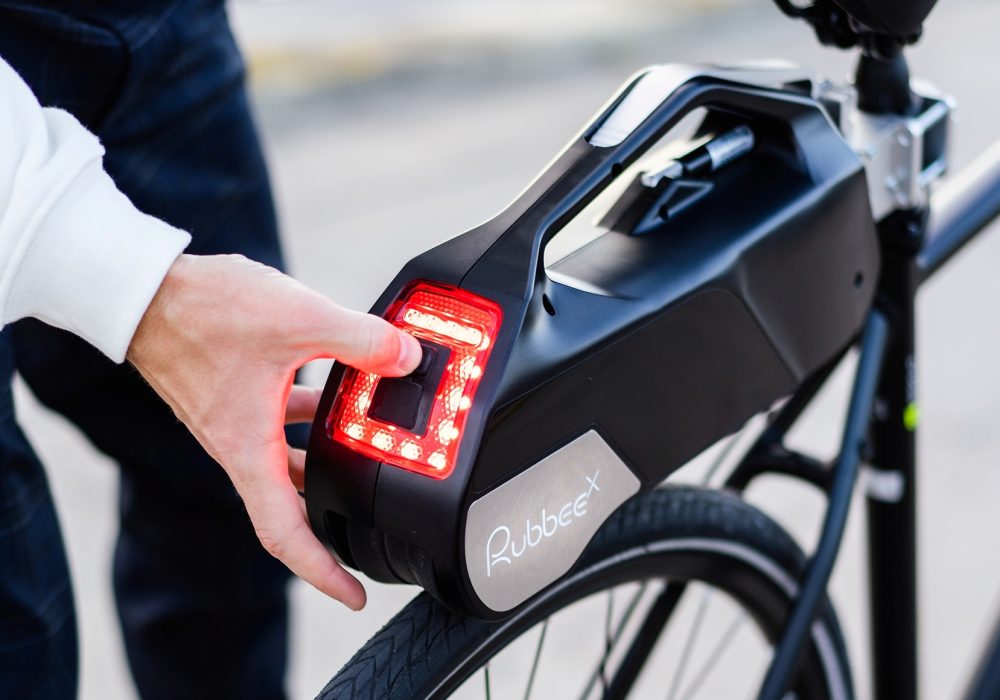
Some modern e-bike conversion kits, such as the Rubbee X simply attach to your bike’s seat post and turn the rear wheel with friction. (Image source: Rubbee.co.uk)
Make sure you pay attention to these potential issues so your DIY e-bike rides as good as new.
-
Geared or Direct-Drive?
If you’re getting a kit with a hub motor, decide whether you want a geared or a direct-drive unit. Direct-drive units are a good solution for flat rides, but geared units are better for very hilly areas.
-
Consider the weight.
Adding a conversion kit is going to increase the weight of your bike. Consequently, this will affect how the bike handles and how it feels to ride it. Make sure to distribute the weight equally on the frame and to put the battery low to the ground to improve the overall balance.
-
Can you do it yourself?
If you’re not a bike mechanic or an electrician, it’s better to find someone who is. Converting the bike yourself will decrease the costs, but it can also increase them if you mess something up.
-
Ensure there is enough space on the bike.
Before purchasing a particular conversion kit, make sure that there is enough room for the parts to fit on the bike. Specifically, check whether there is enough clearance in the fork/rear dropouts/bottom bracket for the motor and that there is enough room in the frame for the battery.
-
Make sure the kit is road legal.
Not all conversion kits are road legal. Depending on where you live, the rules can be more or less stringent. The laws typically limit the use of a throttle and the power of the motor, so make sure that you’re familiar with these before getting a kit that you won’t be able to ride legally.
-
Consider the brand’s reputation.
Finally, consider the reputation and the quality of the brand when buying a conversion kit. There are many cheap kits from China that you can purchase for less than $200 most of the time. But are these worth the hassle?
8 Common Myths About E-Bikes
E-bikes have an undeserved bad reputation with some people. In most cases, the main reason is a lack of information about what an e-bike is and isn’t and about what it can and can’t do.

Image source: Juicedbikes.com
As a result, there are many myths that get passed around without questioning their truth. We believe that fact is stronger than fiction, so let’s debunk the biggest and most misleading ones.
-
Myth 1: E-Bikes Are Fast and Dangerous
Fact: Electric bicycles are neither of these two things. Most e-bikes have a maximum assisted speed of between 15 and 28 mph, which is not at all much faster than regular bikes. These speeds are pretty similar to road bikes. The only difference is that you can maintain that speed for longer thanks to the electric components.
-
Myth 2: Electric Bikes Are Way Too Heavy
Fact: E-bikes are a bit heavier than regular bikes, but not by much. Regular bikes weigh around 30 lbs on average, whereas e-bikes weigh around 50 lbs on average. This is a negligible amount considering the extra power and assistance the motor provides to the rider.
-
Myth 3: Electric Bikes = Cheating!
Fact: E-bikes don’t equal cheating, they equal empowering! If you’re riding an e-bike, it does not mean that you’re cheating, it means that you’re riding past your current abilities, which is the only way for some people to ride. Plus, you can still get a hard workout on an e-bike and lose weight, if that’s your goal. Just don’t go around stealing people’s Strava QOMs/KOMs, pretending you’re on a road bike.
-
Myth 4: E-Bikes Require Maintenance and Don’t Last
Fact: This is a myth. Electric-assist bicycles require the same amount of maintenance, most of the time. On a day-to-day basis, all you need to do is clean and lube the chain, inflate the tires, and make sure the brakes and derailleurs are adjusted. Of course, you also need to charge the battery. If you buy a quality e-bike, the electric components rarely need any maintenance or repairs. Read more about this in our electric bike maintenance and repair guide.
-
Myth 5: Electric Bicycles Are for Lazy or Old People
Fact: This is one of the biggest and most misleading myths about e-bikes. They’re a great option for everyone, not just for people who are lazy, injured, or too old to pedal hard every day. Even if you’re a road racer, you can benefit from an e-bike—instead of getting too tired from your Z2 work commute, save that energy for structured training afterwards by commuting on an e-bike.
-
Myth 6: E-Bikes Are Not Environmentally Friendly
Fact: Are e-bikes as clean as regular bikes? They’re not, but they are still considered environmentally friendly, especially when compared to cars. E-bikes don’t produce toxic exhaust fumes and their batteries and electronic parts can be recycled and reused. By swapping your car for an electric bike, you will be doing the environment a huge favor.
-
Myth 7: Electric Bikes Are Expensive
Fact: This is another common myth about e-bikes. The cheapest e-bikes cost the same as regular bikes and the most expensive e-bikes are not more expensive than the priciest regular bikes. You can get a budget e-bike for less than $500, a mid-range model for $1,000 to $3,000, or you can go all-in and get a high-end model for much more than that. Therefore, there’s an e-bike out there for everyone’s budget.
-
Myth 8: You Can’t Ride an E-Bike in the Rain
Fact: The electrical components on most e-bikes are sealed and fully waterproof. The only exception is some ultra-cheap e-bikes made in China that cut costs by skipping this step. So, can you ride an electric bike in the rain? Absolutely! E-bikes can be ridden in all conditions, just like regular bicycles, just avoid riding in severe downpours.
Frequently Asked Questions
-
Is it worth getting an electric bike?
Yes, e-bikes are definitely worth the money. If you feel like you need some assistance when pedaling, for whatever reason, you will benefit from an e-bike. It will allow you to go faster, save time, and pedal for longer without getting tired.
-
What are the disadvantages of electric bikes?
The main disadvantages of e-bikes are weight, cost, and complexity. Namely, neither of these three downsides are dealbreakers, but e-bikes are heavier than regular bikes, more expensive, and more complicated to use.
-
Do electric bikes charge when you pedal?
No, most electric bikes do not charge when pedaling, but there are some models that do. It all depends on what e-bike you have and what kind of electronics it uses.
-
How fast does an electric bike go?
Depending on the class, e-bikes have a maximum assisted speed of between 15 and 28 mph. However, if you keep pedaling, you can go faster than that, even though the electric motor will no longer be assisting you.
-
Do you need to pedal an electric bike?
Yes, most electric bikes need to be pedaled. The motor is there only to supplement power to the rider and make pedaling easier. The exception to this rule is e-bikes with a throttle, which can move the bike without pedaling. However, using the throttle too much will usually drain the battery too fast so this is not a practical solution.
-
What should I look for when buying an e-bike?
When buying your next e-bike, you should pay attention to the brand, the mechanical and electronic components, the power and the range, the frame, and the size of the bicycle. These are the most important features to consider, but all other matter as well and should not be taken lightly.
-
Can an electric bike go up hills?
Yes, electric bikes can go up hills. Depending on the type and power of the motor they have, they will be slower or faster up very steep hills. For example, geared hub and mid-drive motors are superior to direct drive motors when it comes to uphill rides. Also, it is advisable to get a motor that has more than 250W of power if you live in a very hilly area to get the pedaling assistance you need.
-
Can you lose weight on an electric bike?
Yes, you can easily lose weight on an electric bike. Even though an electric bike has a motor, you’re still doing most of the work by pedaling. If you want to get a good workout and burn calories, you can simply reduce the assistance level and pedal harder.
-
Are electric bike conversion kits any good?
Electric bike conversion kits are a good solution for riders on a tight budget or those who are not ready to say goodbye to their current bicycles. Depending on how much money you’re willing to spend and how good your current bicycle is, you can end up with a high-quality electric bicycle that will serve you for years and thousands of miles.
-
How long do batteries last on electric bicycles?
The Li-ion batteries on e-bikes are usually rated for around 800 full charging cycles or 2,000 half charge cycles. Therefore, they can last for at least three years of everyday cycling and charging.
-
Are electric bikes good for exercise?
Yes, e-bikes are a good option for exercising. You can still pedal hard and get a good workout by lowering the assistance level. As a matter of fact, when you get too tired, instead of going home, you can keep pedaling and working out by increasing the assistance level. In that regard, they’re even better for exercising than regular bikes.
-
Can I ride an electric bike in the rain?
Yes, you can ride most electric bicycles in the rain. Most e-bikes have electric components that are sealed and fully water-resistant. Therefore, there is no reason not to ride them in the rain or even in the snow.
-
Can you ride an e-bike with an empty battery?
Yes, you can still ride an e-bike even if the battery is completely empty. You won’t be able to use pedal-assistance or the throttle, but you can turn the pedals as you would on a normal bike. The only problem is that e-bikes are usually a bit heavier than regular bikes, so you might have a problem pedaling too far this way.


